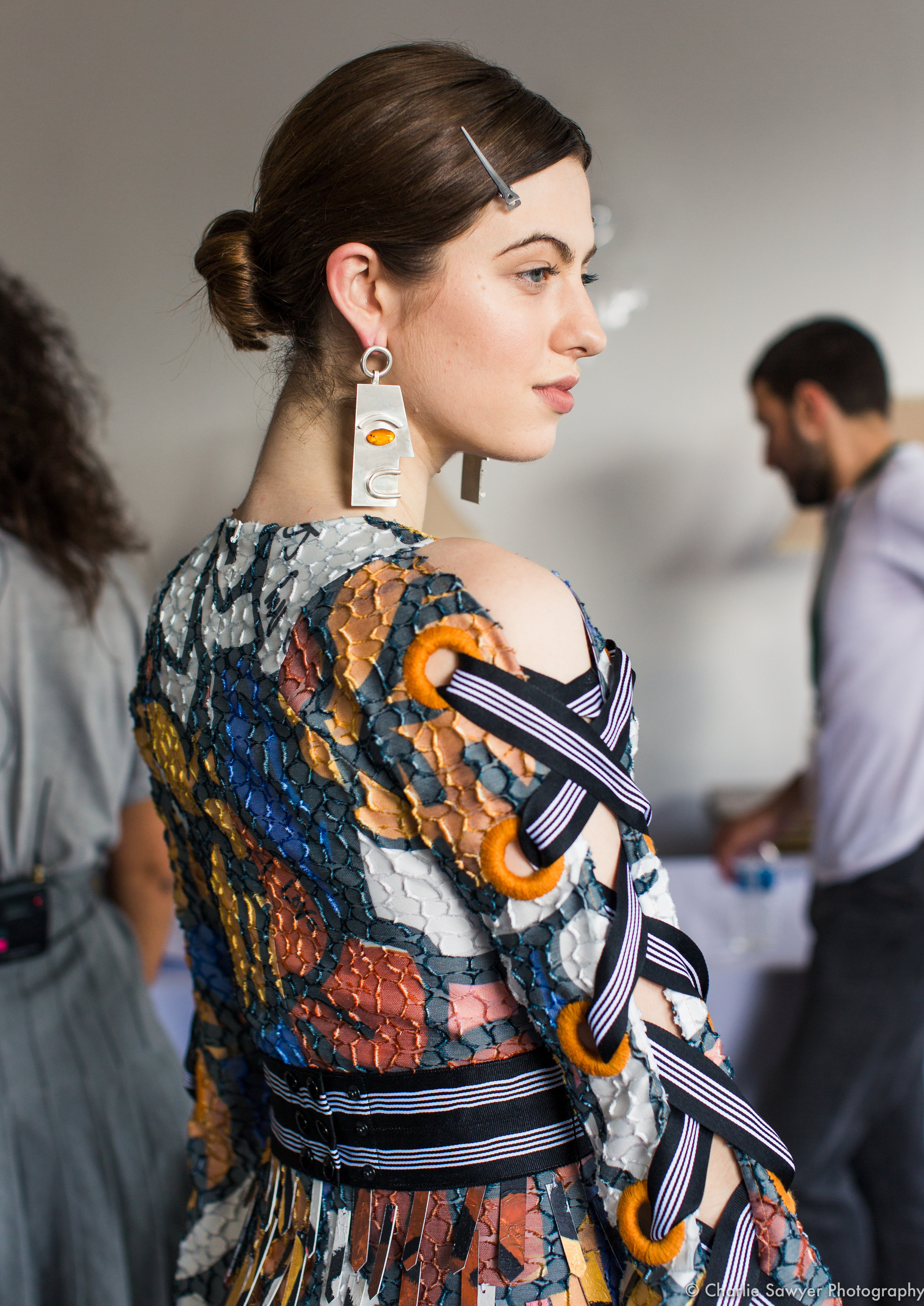The 2018 finalists and their winning looks.
“The design talent and innovation this year has blown me away,” said Livia Firth. The founder and creative director of the sustainability consultancy Eco-Age was among the panel of judges who travelled to Paris during couture week to select the finalists for the CNMI Green Carpet Talent Competition’s Franca Sozzani GCC Emerging Designer Award. Part of the Green Carpet Fashion Awards, now in its second year, the competition challenges emerging designers to redefine sustainability in fashion, drawing on the Italian supply chain, with the winner given the opportunity to present at Milan Fashion Week.
Carmen was among the panel of judges.
Joining Livia and Carmen on the judging panel were Edward Enninful, Ellie Goulding, Derek Blasberg, Petra Nemcova, Camille Charrière, Natalie Kingham, Jenke Ahmed Tailly, Carlo Capasa, Desirée Bollier and Hu Bing, and the illustrious group selected five finalists from a short-list of ten. “The designers we’ve seen are not only highlighting traditional Italian craftsmanship, but also creating their own materials when they can’t find sustainable solutions on the market,” said Livia, with innovations including sequins laser cut from used plastic bottles, rhubarb tanned leather and graphite upcycled from the tech industry used as a substitute for chemical dyes featuring among the designs presented.
Here are the five successful finalists, and their winning looks, who will attend the Green Carpet Fashion Awards at the Teatro alla Scala on 23rd September during Milan Fashion Week.
Teatum Jones
Catherine Teatum and Rob Jones are the designers behind this socially conscious womenswear brand. Graduates from Ravensbourne College of Design and Central Saint Martins respectively, the London-based duo launched their label in 2011, which puts craftspeople at the heart of its creations, and the award-winning-brand is now a regular fixture on London’s official runway schedule.
For the competition, the designers created a dress made from Fil Coupe, produced in Italy from recycled polyester and Lenzing Modal, which is a low impact fabric derived from responsibly sourced wood. Lined with recycled polyester, it was embellished with laser cut sequins made from recycled plastic water bottles and painted with natural pigment paints.
The accompanying coat was made from hand woven Baoule Kente Ikat fabric sourced from Piece & Co., a social enterprise which helps to empower communities around the world, as well as archive and past season fabrics, and it was lined with old printed strike-offs.
Gilberto Calzolari
Born and raised in Milan, Gilberto Calzolari graduated from the Academy of Fine Arts of Brera and began his career in the fashion industry working for some of Italy’s most prestigious luxury brands. He launched his own label in 2015, which is rooted in the Milanese tradition of luxury with a focus on highest quality production techniques, tailoring and craftsmanship, and presented his first capsule collection for the Autumn/Winter 2017-2018 season.
Gilberto’s Green Carpet design was created from used jute coffee bags, originally from Brazil. The bags were purchased from the Navigli vintage street market in Milan, sold as water barriers to stop canals flooding, which is an increasing occurrence due to climate change. The dress has been lined with an archive fabric, and is embellished with Swarovski Advanced Elements lead free crystals.
WRAD
Starting life as a vision for social change, Matteo Ward, Victor Santiago and Silvia Giovanardi quit their corporate jobs in fashion in 2015 to launch WRAD as a means of turning fashion’s negative global impact into an opportunity for progress. The co-founders work to find designs and items that best enable them to communicate their positive message, and all of their pieces are made in certified facilities in Italy and Scotland.
Created from ‘mint fabric’ made from 50% mint bamboo viscose and 50% GOTS (Global Organic Textile Standard) certified organic cotton, WRAD’s competition entry, manufactured in Pistoia, Italy, features recycled graphite dyeing. Manufactured with recycled graphite powder, this chemical dye substitute is a natural and non-toxic mineral that otherwise would be disposed of in landfill.
Behno
Founded by Shivam Punjya, New York-based Behno operates its own factory in a small village in the western state of Gujarat in India that not only produces the brand's high-end clothing, but has also been designed to improve the lives of its workers. Operating under a set of 'Behno Standards', the socially-driven project aims to address garment worker health, social mobility, women's rights, family planning, worker satisfaction and benefits, and eco-consciousness.
Behno’s Green Carpet gown was created by deconstructing and reconstructing unused garments, combined with luxurious GOTS certified organic silk and ECONYL® regenerated nylon, a yarn made by recycling discarded fishing nets and carpets.
Davide Grillo
Born in La Spezia, Davide Grillo first studied fashion in Parma before attending Central Saint Martins in London. Subsequently combining his work as a designer for Pinko with further study, and following a spell at Dolce & Gabbana, he founded his own brand, focusing on craftsmanship and traditional processes, and launched his first collection for Spring/Summer 2017.
Davide’s look included a cape covered in silk ‘feathers’, which had been laser cut from naturally-dyed silk, and a gown featuring Italian hand embroidery by Pino Grasso, hand-painted designs ‘stamperie verga’ using onion skin, logwood, and walnut shell, and embellished with ReSequins, laser cut from plastic bottles.
Related Reading:
Chopard x Giambattista Valli: Championing Sustainable Fashion
The Green Carpet Awards: Celebrating Sustainable Fashion













